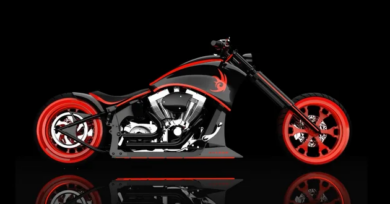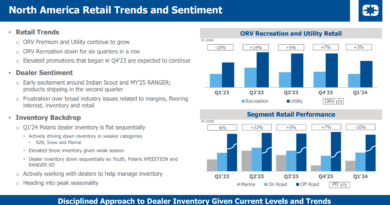Jun. 2, 2008 – The reality behind recycled steel
By Steve Bauer
Managing Editor
Many brake and engine manufacturers advertise their products as fashioned from pure stainless steel, but in nearly all cases those components contain some degree of recycled materials. This isn’t a concern for the majority of customers who ride for recreation, but serious problems can arise when extreme temperatures cause high percentage recycled steel to curl and in some cases even break.
But trying to figure out what concentration of recycled steel is in any given product is more of a guessing game than an exact science. Though the U.S. government grades steel based on its percentage of recycled material, those grades are not listed on any product labels, leaving only manufacturers to know the exact amount.
Things become even more difficult when steel is shipped from overseas manufacturers, which follow their specific country’s guidelines. In countries such as China, for example, steel tends to be mixed with high concentrations of scrap material, whereas in Europe, that number is significantly lower, sometimes as little as only 5 percent.
“If you take two brake rotors, one of ours and one from a Chinese manufacturer, they might look identical when placed side-by-side,” said Sandro Milesi, COO of brake manufacturer Galfer, which is headquartered in Spain and also purchases a majority of its steel from European distributors. “But in most cases the extra cost associated with one product over the other has much to do with the amount of recycled steel that it contains. The majority of Chinese steel I have seen has upwards of 80-90 percent recycled steel, where our recycled steel concentration is very low.”
Milesi says he has seen first-hand what happens to high-percentage recycled steel when it is subject to extreme temperatures commonly involved in a racing environment.
“After two or three laps around the track, I’ve seen some Chinese rotors peel like a potato chip,” he said. “As steel gets hot it is supposed to have the ability to flex but not bend to extremes, and that’s what is happening with a lot of these high-percentage recycled steel products. In some cases I’ve seen it even snap off, causing the rider to lose all braking control.”
Big steel’s governing body
Although each country has its own regulations regarding recycled steel, the steel industry does have a governing body, the International Iron and Steel Institute (IISI). The IISI represents approximately 180 steel producers (including 19 of the world’s 20 largest steel companies), national and regional steel industry associations and steel research institutes. According to IISI, its members produce around 75 percent of the world’s steel (excluding China) and the growing membership in China now accounts for more than 20 percent of Chinese production.
John Surma, chairman and CEO of the IISI’s U.S. division, says members of the organization agree to abide by certain recycled material concentrations when it comes to production of stainless steel products that will be used for housing, transportation and other areas where safety is a concern. He notes that U.S. manufacturers, for example, are mandated by the U.S. government to incorporate no more than 25 percent scrap iron into stainless steel for use in motor vehicles, including powersports. Under IISI guidelines however, member companies cannot exceed 20 percent concentration.
“It isn’t a secret among steel producers that higher concentrations of recycled scrap can weaken the material’s overall durability, and that’s why our regulations and the regulations of many countries across the world keep those concentrations low when it comes to areas where human life is potentially at risk,” he said. “What we cannot control, however, are non-members that create high-concentrate recycled steel and sell it to unknowing distributors and manufacturers under the premise that it is as safe as others.”
Surma says it’s impossible to tell one type of stainless steel from another once it has been manufactured, and that only computer analysis can determine the level of recycled steel in a particular product. The problem, he says, is no government to date has mandated an analysis before it is allowed to be sold in its country, which allows any non-IISI member to add as much scrap iron to its steel as it wants, selling it at a much lower price than their competitors.
“The biggest culprit right now is Chinese manufacturers,” Surma said. “The country is growing so rapidly in terms of its resource production that many of these manufacturers have no interest in staying in the business for the long term. It’s a cat-and-mouse game they are playing, and it’s weighed heavily in their advantage because federal governments don’t have this issue high on their priority list.”
U.S. regulations
The recycling of scrap steel from cars and old buildings has a long history in the United States. The reason is steel is relatively easy — and profitable — to recycle. With the rapid growth of recycled steel in the past 20 years and the benefits it provides to the environment, the U.S. government now requires all steel produced in the U.S. to contain at least 25 percent recycled steel.
Bill Heenan, president of the Steel Recycling Institute, says 30 percent is the U.S. government limit for motor vehicles and steel framing.
“The U.S. government actually has a grading system for steel producers, with 30 percent concentration and lower considered ‘prime’ steel,” Heenan said. “From there the amount of recycled steel that can be used goes up depending on what the steel is to be used for.”
Heenan says computer components are set at 50 percent, furniture 75 percent and every day office supplies are typically composed of 100 percent recycled steel (metal binders in a notebook, for example).
“No matter what kind of steel you use that originates in the U.S., you simply can’t get virgin steel,” he said. “It is possible to get, but you’d have to import it internationally, most likely from Europe.”
So if steel is so tightly regulated by the government, why isn’t its concentration available for consumers to see on the packaging? Heenan says the U.S. government doesn’t require it because if the steel originates in the U.S., it can’t be sold to distributors or manufacturers for purposes other than what the steel was created for.
“Dealers and consumers are at a disadvantage because if a company is based in the U.S. but buys its steel from China or somewhere else, you have no idea where it could come from. It’s an issue that we and the IISI are working closely with the U.S. government on to require all packaging to state where the steel originated from, and whether that steel manufacturer is an IISI member or not.”
Dealer reaction
Interviews that Powersports Business conducted with dealers showed none were aware of the discrepancies in recycled steel between competitors. In fact, some even vowed to only buy from manufacturers that would be able to provide recycled steel numbers for their products.
“I know a lot of my customers buy on price, figuring why spend that extra $100 or more when these rotors or other parts look identical?” said Will Kennedy, owner of Kennedy Powersports in Brownville, Texas “You don’t know what that consumer will do with an ATV or motorcycle once they leave your shop, and if they ride it hard or beyond ‘recreational’ limits, I’ll be the one they come back to if there’s an accident or the part breaks on them.”
Robert Tatum of Crystal Cycle in Bridgeport, Conn., says many customers won’t even bother to look at higher-priced steel parts because they don’t see the value in paying the extra money.
“They’d much rather skimp on the part and use the money they saved to buy an accessory,” he said. “But other than brand recognition, it never occurred to me, either, why some manufacturers charged so much more for their products than others. Now that I’m more aware I’ll make it a point from now on to inform my customers, as well.”




